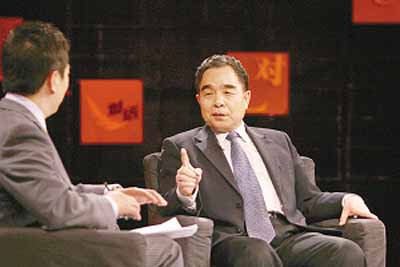|
 |
|
Liu Binjie, Minister of the General Administration of Press and Publication, is interviewed by CCTV on April 19 | China is to forge six or seven domestic first-class large publishing enterprises with both their sales volume and assets surpassing 10 billion yuan ($6.8 billion) and enable them to become well known in the world in three to five years, according to a policy document circulated early this month by the General Administration of Press and Publication (GAPP).
The announcement states that all local governments and institutions of higher learning should turn their for-profit publishers of books, audiovisual products and e-publications into more business-like firms by the end of 2009. For-profit publishing houses attached to Central Government departments and institutions should separate from the Central Government and complete the transformation before the end of 2010.
The circular encourages and supports publishing houses under the central and local governments to become market-oriented companies and merge and reorganize into syndicates. All investors, especially those from state-owned businesses, are encouraged to take part in the restructuring of publishing houses into shareholding companies. Furthermore, established and especially interregional publishers will receive active support from the government to list themselves on stock markets.
The document urges publishing houses to adopt practices that combine both traditional and new emerging media.
"The issue of the circular is a part of efforts to cope with the current global financial crisis, as the publishing sector plays a key role in China's efforts to guarantee economic growth, people's livelihoods and social stability," GAPP Minister Liu Binjie was quoted as saying by the China Press and Publication News on April 20.
"The issue of the circular is also due to the fact that the current publishing system is not able to adapt to the needs of the sector's development and people's demand for cultural products, as well as the international publishing industry," he said.
For instance, the newspaper subscription rate in developed countries is 100-200 per thousand people, compared with 70 in China. Although the output value of China's publishing industry totaled 85 million yuan ($12.44 million) in 2008, contributing 2 percent of GDP, it's too low compared with the United States whose media account for 33 percent of its GDP.
But it's not easy to realize mergers between different sectors and regions. Given this problem, Liu said the Central Government has asked its own publishing houses to restructure themselves into market-oriented companies by the end of 2010. The aim is to provide a sound environment for trans-sector and trans-regional mergers.
To realize its target of establishing six or seven publishing giants, the government encourages its major media to collect money through channels such as stock market listings, cooperation with large state-owned enterprises and links with private businesses.
"In addition, development of the publishing sector will help create jobs, as the current number of employees in the publishing sector has already hit 11 million, leading the world," Liu said.
China's publishing sector and related industries have long been considered less open than other sectors in the country. Newspaper and magazine offices and publishing houses, and even printing houses, were all under the administration of state-owned institutions before the 1980s.
In 1992, China issued the Copyright Law and joined the Universal Copyright Convention, a move symbolizing China's entry into the world publishing industry.
However, as said in the document, China's scattered publishing houses have failed to become mainstays in the market, due to their small scale and less competitive edge.
China has completed trial reforms at 21 media publishing houses since 2003. Meanwhile, overall reform in the whole sector is proceeding nationwide. "The key of reform is to turn for-profit publishing houses into market-oriented businesses, improve their market competitive edge, and give them full decision-making power," GAPP Vice Minister Jiang Jianguo told China Radio International on April 7.
Thus far, China has established 25 publishing group corporations. More than 260 presses and publishing houses and 1,000 for-profit newspapers and periodicals have become market mainstays, and 11 publishing and distribution groups have gone public, collecting more than 24 billion yuan (3.53 billion).
"The trial reform has laid a good foundation for promoting overall reform and accumulating experiences for exploring managerial mode and operation methods," said Jiang. | 